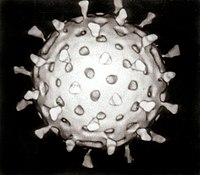
Photo from wikipedia
INTRODUCTION: Chikungunya fever is a condition resulting from infection by chikungunya virus (CHIKV), an Aedes sp.-transmitted virus. This disease has been diagnosed in thousands of cases in the Americas, particularly… Click to show full abstract
INTRODUCTION: Chikungunya fever is a condition resulting from infection by chikungunya virus (CHIKV), an Aedes sp.-transmitted virus. This disease has been diagnosed in thousands of cases in the Americas, particularly in Brazil, in recent years, and there is an ongoing epidemic of chikungunya fever in Brazil that began in 2014. Clinical diagnosis is difficult; only a few cases have been confirmed by laboratory tests due to the low number of specific, efficient tests available for virus or antibody detection. Here, we aimed to evaluate different polymerase chain reaction (PCR) approaches for detection of CHIKV genetic material. METHODS: Specific primers and probes within the viral capsid gene region were designed for this work. To evaluate the analytic sensitivity of detection, human sera were spiked with serial dilutions of the viral stock. Several PCR protocols were performed to investigate the sensitivity of CHIKV RNA detection in serum dilutions ranging from 106 to 1 PFU equivalents. RESULTS: The technique showing the greatest sensitivity was a real-time PCR assay using specific probes that could detect the genetic material of the virus at all dilutions, followed by conventional PCR. Digital PCR showed low sensitivity and was much more expensive than other technologies. Digital PCR should be used for specific purposes other than clinical diagnosis. CONCLUSIONS: Although quantitative PCR using probes was more expensive than the use of intercalating dyes or conventional PCR, it had the highest sensitivity out of all tested PCR approaches.
Journal Title: Revista da Sociedade Brasileira de Medicina Tropical
Year Published: 2017
Link to full text (if available)
Share on Social Media: Sign Up to like & get
recommendations!